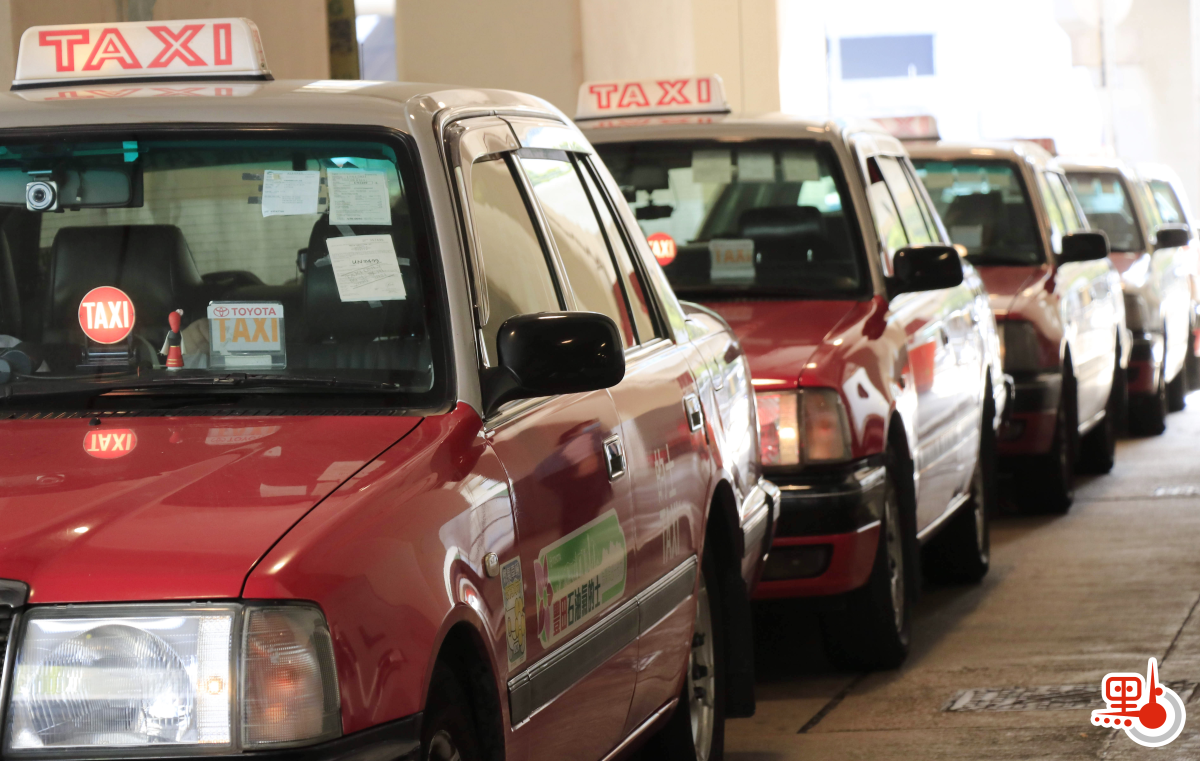
The Transport and Logistics Bureau (TLB) has proposed legislative amendments to improve the quality of taxi services, and Ta Kung Pao has launched a special series to shed light on the problems and challenges of the taxi industry through practical observations and in-depth discussions. The first part discusses the difficulty of hailing a taxi from the perspective of passengers.
During the past five days, the reporters from Ta Kung Pao conducted a survey of taxi services at different time periods. During peak hours, up to 30 people queued up at taxi stands and waited for more than 15 minutes. During other time periods and places, some drivers refused to take passengers for different reasons, including being out of the driver's way, designating the Western Harbour Crossing for crossing the harbour, and being ready to hand over their shifts, and so on.
Some members of the public said helplessly that although they knew that it was illegal for taxis to refuse to take passengers, they had no time to call the police because they were in a hurry. The Taxi Drivers' Union said that the quality of some drivers varies and suggested that the Government should regulate the entry requirements for drivers and impose heavy penalties on offenders.
The reporters conducted 14 taxi ride tests on July 6 and 10 at different time periods in Kowloon, Hong Kong and the New Territories respectively throughout the day, and found that there were different kinds of difficulties, and some drivers even refused to take passengers.
Admiralty Taxi stand: waiting more than 15 minutes
During the rush hour at 9:00 a.m. on July 9, Ta Kung Pao reporters saw on the spot that as many as 30 people were queuing up at the Admiralty taxi stand, with waiting time of more than 15 minutes, and people at the back of the queue were so anxious that they could not get on the bus even after a long time.
A reporter visually estimated that the queue time was already more than 15 minutes, so he had to take a taxi elsewhere. Finally, by "walking", he just met a passenger who had dropped off the taxi, and luckily boarded a taxi outside the station, but he had to spend another 5 minutes to do so.
In another test, one reporter took a taxi in San Po Kong at 8:40 a.m. yesterday. There were quite a number of people waiting on the street, but there were very few unladen vehicles on the way, so the reporter changed places and took about 15 minutes before he succeeded in hailing a taxi to the Four Seasons Hotel in Central.
On another occasion, at 7:40 p.m. on July 6, some reporters departed from the bus stop of Grantham Hospital on Wong Chuk Hang Road to the Caritas Ovation International Hotel in Tin Wan. After waiting for five minutes, they saw two taxis coming and waved, but the drivers turned a blind eye to them. After two unsuccessful attempts, the reporters finally boarded the taxi, but the driver refused to take them on the grounds that he was unfamiliar with the traffic in Tin Wan and advised the reporter to change the waiting direction and choose other ways of transportation, which was virtually refusing hire.
For the rest of the different time periods and places, it took 5 to 10 minutes on average to take a taxi, but one has to "know how to maneuver" in order to succeed in 10 minutes. During the process, it was even found that some drivers would refuse to take passengers for different reasons, including being out of the driver's way, designating the Western Harbour Crossing for crossing the harbour, and being ready to hand over their shifts, and so on.
"Passengers say that it is difficult to take a taxi, but the taxi sector often reports that taxi drivers drive for half an hour on the street without seeing a single passenger!" Mr Leung from the Taxi Branch of the Motor Transport Workers General Union believes that the difficulty of hailing a taxi is due to the crowd effect during peak hours and suggests that the public use online booking apps to call taxis.
Under the Road Traffic (Public Service Vehicles) Regulations (Cap. 374D, Laws of Hong Kong, Section 37), it is an offence for taxi drivers to refuse hire, and they may also commit an offence if they selects a passenger. Any person who contravenes the relevant legislation is liable on conviction to a fine of HK$10,000 and imprisonment for six months.
Councillor: Fewer unladen vehicles on the streets due to prevalence of taxi apps
As for some drivers refusing hire for different reasons, Mr Leung believes that the quality of drivers in the industry varies, and hopes that the Government will regulate the entry requirements for drivers and impose heavier penalties on those who fail to comply with the law. With the diversion of the three tunnels, the congestion will be improved to facilitate cross-harbour drivers to make their return trips, and it is believed that the situation where drivers refusing to take passengers across the harbour will also be improved accordingly.
Tang Ka-piu, a member of Legislative Council, opined that it was relatively more difficult to get a taxi during peak hours and at night, and that taxi drivers using apps to take orders earned a higher average income, thus affecting the number of unladen taxis running on the streets and the success rate of on-the-road taxi rides at other times of the day.
Mr Tang believes that more and more people choose to use mobile apps to call for taxis, and the related software also has e-payment, which is believed to be the future trend. In addition to the promotion of taxi apps, it is suggested that a certain percentage of taxis should be reserved for people on the street after the introduction of the fleet system in the future.
Test 1
Short distance
The CCC Mongkok Church Kai Oi School to Nam Cheong MTR Station
Failed four times to call a taxi with the app
At 2:13 p.m. on July 6, the reporter ordered a taxi from the "HK Taxi" mobile phone application for a 1.7-kilometer journey from the CCC Mongkok Church Kai Oi School in Cheung Sha Wan to the Nam Cheong MTR station, with a system estimate of HK$27. When the order was placed for the first time, a driver answered the order about 2 minutes later, but the order was canceled immediately. The driver called and replied that he had misread the order and the request for a 20% discount could not be acceptable. The reporter then canceled the discount request, but later the order was automatically canceled three times due to "timeout" and no one answered the order.
Test 2
Short distance
Grantham Hospital Bus Stop on Wong Chuk Hang Road to Caritas Oswald Cheung International House, Tin Wan
The driver refused to take the passenger and claimed that he was not familiar with the road.
At 7:40 p.m. on July 6, the reporter departed from Grantham Hospital Bus Stop on Wong Chuk Hang Road to Caritas Oswald Cheung International House and waited for five minutes, but was met by two taxis who ignored his beckoning call, and then succeeded in getting a taxi. However, the driver said he was not familiar with the traffic in Tin Wan and advised the reporter to change the waiting direction. 1 minute later, the reporter successfully took a taxi, the driver said, whether to receive short-distance passengers depends on the driver's mentality and scope of work, "whether it's on the right way or not, and whether they like it or not, maybe the reason."
Test 3
Crossing the sea
Hoi Lai Estate Taxi Stand to Central Government Offices in Admiralty
Drivers are required to go through the Western Harbour Crossing
At 8:37am on July 10, the reporter stopped a taxi at the Hoi Lai Estate taxi stand. There were 3 passengers waiting for the taxi, and the reporter waited for about 5 minutes before getting into the taxi. When getting into the taxi, the reporter asked the driver to go to the Central Government Offices in Admiralty. The driver said, "I can only go to the Western Harbour Crossing (WHC), but not to the Cross Harbour Tunnel (CHT)". When asked about the reason, the driver said, "This is the morning rush hour, until 12 noon, and there will be traffic congestion at the CHT, at least for 20 minutes, and no driver will be willing to 'take care of you'". When asked why fewer taxis pick up passengers at the taxi stand during this time, the driver responded, "During rush hour, there are fewer empty buses, and we drivers can pick up passengers on the road, so we seldom enter the stand".
It is not easy to take a taxi: short-distance rides booked with Apps, but orders have been withdrawn four times
Is it easier to book taxi services through cell phone applications (apps)? A reporter from Ta Kung Pao conducted a test and found that calls made through apps may not always be successful, and the success rate for short trips is even lower, with orders being withdrawn on four occasions and calls not being successful. According to the industry, more than 80% of taxi drivers in Hong Kong have already used apps to take orders, which can help increase their income, but it still depends on the situation when taking a taxi during peak hours.
There are many different taxi apps in the market, including "HK Taxi", "Fly Taxi", "Uber" and "God Taxi", etc. It is very simple to use, just enter the origin and destination, then submit the order and wait for the driver to take the order, and the payment can be made by cash, credit card, Octopus, or e-payment deduction, and the passenger can even ask for a discount.
At around 2:00pm on July 6, the reporter used the "HK Taxi" mobile application to order a taxi from Cheung Sha Wan to Nam Cheong MTR station, a short distance of about 1.7 kilometers, with the system estimating the price at HK$27. When the order was first placed, a note was made to ask for a 20% discount. About two minutes later, a driver answered the order, but it was immediately canceled, and the driver replied by phone, "I misread the order, and I can not accept a 20% discount. The reporter then modified the content to stop asking for a discount, but the order was canceled by the platform three times due to "timeout".
Drivers are required to split the bill with the platform
Mr Leung from the Taxi Branch of the Motor Transport Workers General Union estimated that more than 80% of taxi drivers in Hong Kong have already joined the taxi app to take orders, and that the app's allocation of resources is reasonable, "If a Hong Kong taxi carries a passenger to Tuen Mun, and uses the app to get an order to return to the urban area, even if the charge is cheaper, many taxi drivers will be willing to do so, and it is easier to pick up a passenger."
Passengers are not charged extra for using taxi call apps, but drivers are required to share the cost of the order with the platform. Leung said there were different ways of sharing money among the apps. For example, "HK Taxi" uses a point system, where "the platform scores each order according to the nature of the order, the time it takes, and whether or not the passenger has added any money to the order. Drivers need to buy points in the program, and a different number of points will be deducted from each order, each point will be charged at HK$1, and payment will be made to buy points when the points are used up". As for Uber's share of the profits, it is based on the price of each order, and earns a portion of the passenger's fare.
Wait-and-see: Introducing the "fleet system" to enhance service, but the industry is worried about the high cost
The Transport and Logistics Bureau has proposed legislative amendments to improve taxi services, including the introduction of a fleet system, which was tabled at the Legislative Council for first reading on June 11. Views of the taxi industry are divided. Supporters believe that it will help management, but the formation of a fleet of taxis involves the cost of upgrading equipment, uniforms, driver training, etc., and they hope that the Government will provide a subsidy.
Chairman of the Sai Kung Taxi Operators Association believes that a fleet system to unify the management of taxis can respond to the demand for regional services in a timely manner through fleet scheduling, and may even help to alleviate the problem of "difficulty of hailing a taxi", but it is estimated that initially, only some taxi companies will respond. Individual drivers may be deterred from joining the fleet because they are worried that they will have to pay a fee upfront.
The chairman of the Taxi Dealers and Owners Association pointed out that taxi drivers accounted for nearly 70% of the taxi trade and were self-financing, but the need to receive training, wear uniforms and be managed by the taxi fleet had "tied their hands" or reduced their income, and he believed that the Government should provide financial incentives to encourage the taxi trade to invest in the industry, and hoped that the Government would discuss the matter with the trade.
Chairman of the New Territories Taxi Operations Union, opined that "difficult to get a taxi" is related to the traffic problem, and it does not depend on the fleet system, which does not guarantee the income of the fleet. The formation of a fleet involves the costs of upgrading the equipment, standardizing the uniforms, and the training of the drivers, and it even involves the cost of changing to deluxe taxis in order to achieve a better experience, which is indeed difficult to be afforded by the low income of the trade at present, as "we are already broke after taking out an insurance policy, how can we afford a new car with a price tag of about HK$400,000?"
The Commissioner for Transport Department, Mrs. Law Shuk-pui, said that unlike the licenses of other public transport operators, taxi licenses do not have many operational requirements. Therefore, it is hoped that through the introduction of a fleet system, the management requirements will be increased, and it is believed that the number of fleets in the initial stage of implementation will not be large, but it is hoped that through the branding, more taxis will be attracted to join the fleet.
Hong Kong stopped issuing additional urban taxi licenses in 1994. There are now a total of 18,163 taxis in Hong Kong with a population of about 7.4 million and an average daily passenger volume of close to 1 million, with one taxi for every 407 persons. However, in the major cities of Beijing, Tokyo and Singapore, there is less than one taxi for every 400 persons, so it can be seen that the number of taxis in Hong Kong is even smaller.
According to the Transport Department, there are a total of 18,163 taxis in Hong Kong, with 15,250 in the urban areas, 2,838 in the New Territories and only 75 in Lantau.
In comparison with major overseas cities, London of the United Kingdom, with a population of about 8.98 million, has about 21,000 taxis, with one taxi for every 427 people, which is similar to that of Hong Kong. Tokyo, Japan, with a population of about 14 million, currently has about 40,000 taxis, one for every 350 people.
Beijing, with a population of about 2.154 million, has a total of about 67,000 taxis, with one taxi for every 321 persons. In Singapore, with a population of about 5.46 million and a total of about 14,084 taxis, there is one taxi for every 388 persons. The taxi-to-population ratios of Beijing, Tokyo and Singapore are all better than that of Hong Kong. Shenzhen, with a population of about 17,661,800, has a total of about 21,514 taxis, with one taxi for every 821 people, which is double that of Hong Kong. However, with the development of online car-hailing service in Shenzhen, the shortage of taxis is not prominent.




















Comment